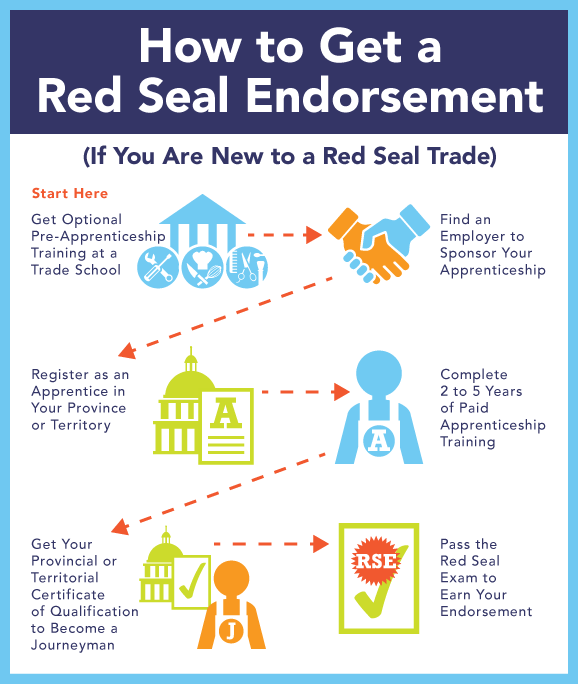Get started now.

Red Seal Trades: What They Are & How to Get Into One
Going into one of the Red Seal trades can be an excellent career option. Canada needs more skilled tradespeople to remain globally competitive. In fact, certified journeymen* play crucial roles in the growth and vibrancy of the nation's economy.
However, many employers find it hard to fill their job openings. They want to hire well-qualified workers. And that means they need an easy way to recognize them. As a result, having a Red Seal endorsement is often the best credential a tradesperson can possess. Canadian employers widely accept it as proof of skills within a particular trade. Of course, getting that stamp of approval first requires getting the appropriate training, and for Red Seal occupations, that involves being a registered apprentice. It's the standard route taken by thousands of people who want to establish a reliable career.
For example, according to Statistics Canada, more than 459,000 apprenticeships were registered across Canada in 2023. Many involved people looking to shift into more viable and satisfying careers. The most popular trades for apprenticeship registrations included electricians, carpenters, automotive service technicians, and plumbers.
Many people have recognized the employment possibilities that such a vocational path can offer. And they've noticed they can take advantage of some of those opportunities at almost any age.
So why not explore this option a little more? Here are answers to nine of the most frequently asked questions:
- What is the Red Seal program?
- What is a Red Seal trade?
- What are the most popular Red Seal trades?
- How do I get Red Seal certification?
- How do I get a Red Seal grant?
- What financial assistance is available for Red Seal apprentices?
- What's on the Red Seal exam?
- Why should I pursue a Red Seal endorsement?
- Where do I register for a Red Seal apprenticeship?
- Which schools can help me get started in a Red Seal trade?
* In this article, we use the terms "journeyman" and "journeymen" since they are the most common ways to refer to fully certified tradespeople. But they are meant to encompass both men and women, just like the term "journeyperson."

Read Seal Trade FAQs
1. What is the Red Seal program?
 It's one of the ways that Canada helps ensure that people have the opportunity to:
It's one of the ways that Canada helps ensure that people have the opportunity to:
- Learn trade skills that closely match the needs of today's employers
- Move anywhere in the country with confidence that those skills will be recognized
Officially known as the Interprovincial Standards Red Seal Program, it provides a system for industries to define common, Canada-wide skill standards. Through the voluntary program, a provincially certified tradesperson can receive an official endorsement that signifies that their knowledge and abilities meet the national industry standard. Some people also refer to the program or its components with the unofficial acronym "IP" (short for "interprovincial").
2. What is a Red Seal trade?
At the most basic level, it's simply a vocation for which you can get a Red Seal endorsement. Not all vocations qualify, and only certain kinds of "compulsory trades" are part of the Red Seal program. A compulsory trade is a vocation that requires a person to be a registered apprentice, a certified journeyman, or a candidate for certified journeyman status in their province or territory.
About 80 percent of all registered apprentices in Canada are in Red Seal trades (also known as "designated trades").
3. What are the most popular Red Seal trades?
At last count, the program included 54 different trades. They include all kinds of hands-on occupations, and each one is deemed a "designated Red Seal trade."
In 2023 alone, the Red Seal program issued almost 37,000 endorsements to tradespeople across Canada. That's according to government data on the number of certificates awarded with a Red Seal endorsement. These were the ten most popular designated trades that year.
Wage data is current as of December 3, 2024, and is based on information from the federal government's Job Bank.
-
Construction electrician
- Endorsements issued: 6,642
- Median hourly wage: $35.00
-
Carpenter
- Endorsements issued: 3,726
- Median hourly wage: $30.42
-
Automotive service technician
- Endorsements issued: 2,886
- Median hourly wage: $28.85
-
Plumber
- Endorsements issued: 2,151
- Median hourly wage: $34.15
-
Industrial mechanic or millwright
- Endorsements issued: 2,055
- Median hourly wage: $35.00
-
Heavy-duty equipment technician
- Endorsements issued: 1,998
- Median hourly wage: $35.00
-
Hairstylist
- Endorsements issued: 1,662
- Median hourly wage: $18.19
-
Steamfitter or pipefitter
- Endorsements issued: 1,032
- Median hourly wage: $43.00
-
Welder
- Endorsements issued: 1,032
- Median hourly wage: $29.06
-
Cook
- Endorsements issued: 612
- Median hourly wage: $17.00 for cooks; $21.50 for chefs
The complete list of Red Seal trades includes other fun vocations such as chef, baker, auto body repairer, and refrigeration and air conditioning mechanic.
4. How do I get Red Seal certification?
 Technically, you get a Red Seal endorsement (RSE), even though you may hear some people informally refer to it as a "Red Seal certificate". The difference is that an endorsement is an extra level of recognition above your provincial or territorial certificate. The endorsement is national, whereas trade certification is regional.
Technically, you get a Red Seal endorsement (RSE), even though you may hear some people informally refer to it as a "Red Seal certificate". The difference is that an endorsement is an extra level of recognition above your provincial or territorial certificate. The endorsement is national, whereas trade certification is regional.
Before getting a Red Seal endorsement, you must earn a Certificate of Qualification (or its equivalent) from your province or territory. And, unless you already have a lot of experience in your chosen trade, this is usually only achieved by completing a registered apprenticeship.
So, with some exceptions, the whole process generally works like the following for anyone new to the trades:
- You find an employer willing to sponsor your apprenticeship. (You can sometimes stand out if you already have a little schooling or experience in the field you've chosen before approaching potential sponsors.) Your sponsor will agree to provide you with paid on-the-job training.
- You register as an apprentice with your provincial or territorial training authority.
- You complete two to five years of training, depending on the trade and your prior experience. Most of the learning occurs in your sponsor's workplace, and the rest happens in a classroom environment at an approved school.
- You pass exams at each level of training, followed by a final certification exam to receive your provincial qualification as a journeyman.
- You write the Red Seal exam for your trade, if applicable. This Interprovincial Standards Red Seal Examination is usually administered through your province's apprenticeship office. Passing it earns you the Red Seal endorsement.
If you already have extensive experience in a particular trade but have not completed a formal apprenticeship, you may be able to challenge the Red Seal exam as a "trade qualifier" or experienced journeyman, depending on your province's criteria.
5. How do I get a Red Seal grant?
Unfortunately, as of March 31, 2025, the Government of Canada has concluded its Red Seal apprenticeship grant programs.
6. What financial assistance is available for Red Seal apprentices?
The Canadian government offers loans for people pursuing designated trades.
The Canada Apprentice Loans can provide registered Red Seal apprentices with as much as $4,000 in interest-free loans per training period. The loans remain interest-free during your training, and you don't have to make any payments during that time. While these loans are not offered in Québec, alternative assistance is available.
Among other eligibility requirements, to qualify for these apprenticeship grants or loans, you'll need to be:
- Graduated from high school
- A Canadian citizen, permanent resident, or protected person
- Officially registered as an apprentice in a Red Seal trade or have proof of journeyman certification
- Enrolled in appropriate technical training with an approved provider
- Able to pass a credit check
7. What's on the Red Seal exam?
Every designated trade has its own Red Seal exam. So the specific content depends on which vocation you've been training for. It will cover areas such as:
- The tasks and activities of your trade
- Technical and trade-specific terminology
- Safety procedures
- Necessary skills for your trade
- The tools and equipment used in your trade
Your exam may also test your ability to perform trade-related math, read and understand diagrams, use the imperial or metric systems, and solve trade-related problems. Every exam consists of between 100 and 150 multiple-choice questions, all of which have equal importance.
Here are some other things about Red Seal exams that are useful to know:
- You're allowed up to four hours to complete your exam.
- You can write your exam in either English or French.
- You'll probably have to pay an exam fee.
- You'll need to bring a government-issued photo ID along with other materials as listed on your exam confirmation letter.
- Personal items such as bags, cell phones, and other electronics aren't allowed when writing your exam.
- Depending on your trade, you may be given documents to reference during your exam.
- You must answer at least 70 percent of the questions correctly to pass.
- It may take as long as four weeks to receive your results.
- If you don't pass on your first attempt, you may be able to retake the exam after a waiting period. Each province and territory has its own rules about additional attempts.
8. Why should I pursue a Red Seal endorsement?
 Earning your provincial Certificate of Qualification is terrific, even if you live in a region where your trade isn't regulated. After all, most employers prefer to hire people with verified credentials. But if you want to move to a different part of Canada, it can be a real advantage to have an extra mark of distinction.
Earning your provincial Certificate of Qualification is terrific, even if you live in a region where your trade isn't regulated. After all, most employers prefer to hire people with verified credentials. But if you want to move to a different part of Canada, it can be a real advantage to have an extra mark of distinction.
The best way to ensure you can work in your desired location is to obtain a Red Seal endorsement. It is the only qualification that can provide you with automatic acknowledgement of your skills in any Canadian province or territory where your trade might have regulatory requirements. In short, it's all about giving you mobility.
But it's also a signal to employers that you can provide excellent workmanship, and it gives them assurance in your abilities, which can give you a major edge in the job market.
9. Where do I register for a Red Seal apprenticeship?
Go to an office in your region for the government department responsible for handling trade certification. Each province and territory has one:
- Alberta: Apprenticeship and Industry Training
- British Columbia: Skilled Trades BC
- Manitoba: Apprenticeship
- New Brunswick: Apprenticeship and Occupational Certification
- Newfoundland and Labrador: Apprenticeship and Trades Certification Division
- Northwest Territories: Apprenticeship, Trades and Occupation Certification Program
- Nova Scotia: Apprenticeship Agency
- Nunavut: Apprenticeship, Trade and Occupations Certification
- Ontario: Skilled Trades Ontario
- Prince Edward Island: Apprenticeship and Trades
- Québec: Emploi-Québec or the Commission de la construction du Québec (CCQ)
- Saskatchewan: Apprenticeship and Trade Certification Commission
- Yukon: Apprenticeship
10. Which schools can help me get started in a Red Seal trade?
Canada is home to many vocational schools that specialize in helping people prepare for a Red Seal apprenticeship. You might want to look into your region's culinary, beauty, and skilled trades programs. Plenty of hands-on educational opportunities exist.




